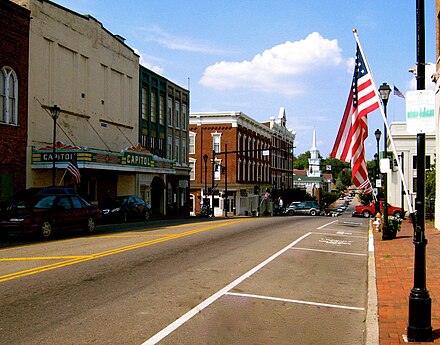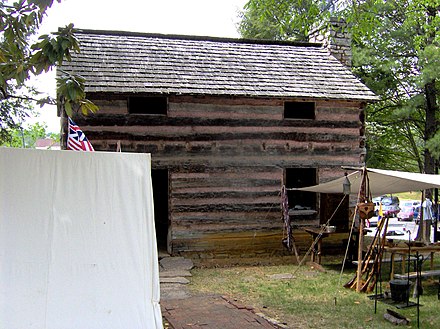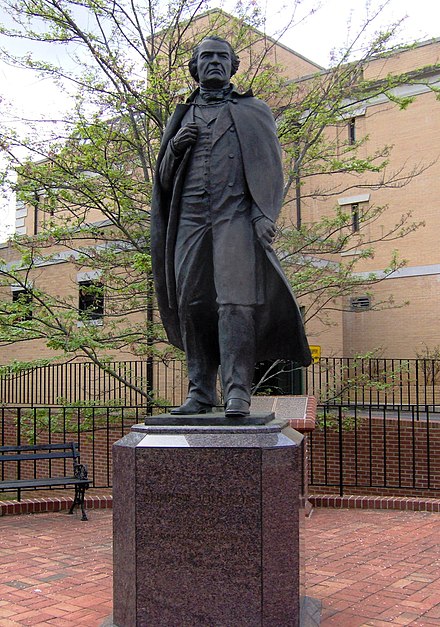Greeneville - town in and county seat of Greene County, Tennessee, United States
 Greeneville is a small town in Tennessee that was the political base of President Andrew Johnson. You can visit two of his homes and his burial place here. The town was the capital of the short-lived State of Franklin in the 18th-century history of the Tennessee region.
Greeneville is a small town in Tennessee that was the political base of President Andrew Johnson. You can visit two of his homes and his burial place here. The town was the capital of the short-lived State of Franklin in the 18th-century history of the Tennessee region.
Understand
Greeneville is notable as the town where United States President Andrew Johnson began his political career when elected from his trade as a tailor. He and his family lived there most of his adult years. It was an area of strong abolitionist and Unionist views and yeoman farmers, an environment which influenced Johnson's outlook. Its population in 2010 was 15,000.
History
Native Americans were hunting and camping in the Nolichucky Valley as early as the Paleo-Indian period (c. 10,000 BCE). A substantial Woodland period (1000 BCE - 1000 CE) village existed at the Nolichucky's confluence with Big Limestone Creek (now part of Davy Crockett Birthplace State Park). By the time the first Euro-American settlers arrived in the area in the late 18th century, the Cherokee claimed the valley as part of their hunting grounds. The Great Indian Warpath passed just northwest of modern Greeneville.
Permanent European settlement of Greene County began in 1772. The county was named after Nathanael Greene, reflecting the loyalties of the numerous Revolutionary War veterans who settled in the Nolichucky Valley.
In 1784, North Carolina attempted to resolve its debts by giving the U.S. Congress its lands west of the Appalachian Mountains, including Greene County, abandoning responsibility for the area to the federal government. In response, delegates from Greene and neighboring counties convened at Jonesborough and resolved to break away from North Carolina and establish an independent state.
 A petition for statehood for the proposed State of Franklin (named in honor of Benjamin Franklin) was submitted to Congress in May 1785, but it failed to gain the requisite votes needed for admission to the Union. The first state legislature of Franklin met in a log cabin in December 1785 in a crude log courthouse in Greeneville, which had been named the capital city. However, the Franklin movement began to collapse soon thereafter, and North Carolina reasserted its control of the area the following spring.
A petition for statehood for the proposed State of Franklin (named in honor of Benjamin Franklin) was submitted to Congress in May 1785, but it failed to gain the requisite votes needed for admission to the Union. The first state legislature of Franklin met in a log cabin in December 1785 in a crude log courthouse in Greeneville, which had been named the capital city. However, the Franklin movement began to collapse soon thereafter, and North Carolina reasserted its control of the area the following spring.
Greene County, like much of East Tennessee, was home to a strong abolitionist (anti-slavery) movement in the early 19th century. This movement was likely influenced by the relatively large numbers of Quakers who migrated to the region from Pennsylvania in the 1790s.
In June 1861, on the eve of the American Civil War, 30 counties of the pro-Union East Tennessee Convention met in Greeneville to discuss strategy after state voters had elected to join the Confederate States of America. The convention sought to create a separate state in East Tennessee that would remain with the United States. The state government rejected the convention's request, however, and East Tennessee was occupied by Confederate forces shortly thereafter. Several conspirators who lived near what is now Mosheim managed to destroy the railroad bridge over Lick Creek in western Greene County on the night of November 8, 1861. Two of the conspirators, Jacob Hensie and Henry Fry, were executed in Greeneville on November 30, 1861. Andrew Johnson, the 17th President of the United States, spent much of his life in Greeneville. In 1826, Johnson arrived in Greeneville after fleeing an apprenticeship in Raleigh. Johnson purchased a tailor shop, which he moved from Main Street to its present location at the corner of Depot and College streets. He was elected to the Greeneville City Council in 1829, and mayor in 1834. As Johnson rose through the ranks of political office in state and national government, he used his influence to help Greeneville constituents obtain government positions. Whilst Andrew Johnson was away from home during his vice-presidency, both union and confederate armies often used his home as a place to stay and rest during their travel. Soldiers left graffiti on the walls of Johnson's home, and evidence of the graffiti remains.
The rural community of Camp Creek south of Greeneville was severely affected by an EF-3 tornado in 2011 Super Outbreak. Six people were killed immediately and a seventh died later. Horse Creek, southeast of Greeneville, was also hit by an EF-3 tornado during the same outbreak. One person was killed in that community. A total of eight were killed in Greene County.
Get in
By car
U.S. Route 321 follows Main Street through the center of the town and connects Greeneville to Newport to the southwest. U.S. Route 11E (Andrew Johnson Highway), which connects Greeneville with Morristown to the west, intersects U.S. 321 in Greeneville and the merged highway proceeds northeast to Johnson City. Tennessee State Route 107, which also follows Main Street and Andrew Johnson Hwy, Greeneville to Erwin to the east and to the Del Rio area to the south. Tennessee State Route 70 (Lonesome Pine Trail) connects Greeneville with Interstate 81, and Rogersville to the north and Asheville, North Carolina to the south. Tennessee State Route 172 (Baileyton Road) connects Greeneville with Interstate 81 and Baileyton to the north.
Tennessee State Route 93 (Kingsport Highway) connects Greeneville to Interstate 81, Fall Branch and Kingsport to the north.
By bus
Greyhound - Offers a limited stop just to the west of town. Quik Stop #45 6736 W Andrew Johnson Blvd, Mosheim
Get around
See

- Andrew Johnson National Historic Site, 121 Monument Ave, 36.158333°, -82.835°, +1 423 638-3551. Apr-Nov: daily 9AM-4PM; Dec-Mar: W-Su 9AM-4PM. The site includes Johnson's tailor shop at the corner of Depot Street and College Street, Johnson's house on Main Street, and the Andrew Johnson National Cemetery (atop Monument Hill to the south). A replica of Johnson's birth home and a life-size statue of Johnson have been placed across the street from the visitor center and tailor shop. Free 2023-01-13
- Capitol of State of Franklin, 204 N College St. This is a replica of the building which is believed to have served as the capitol of the State of Franklin from 1785 until 1788 and which used to stand near the intersection of Main and Depot Streets. The Franklin Legislature, which also met there, challenged the authority of North Carolina by passing laws to levy taxes, raise a militia, establish courts, authorize the performance of marriages, and open a land office. 2020-05-23
- Appalachian Caverns The "wild tour" of Appalachian Caverns can be a big thrill or a chance for your nerves to get the better of you.
- Davy Crockett Birthplace State Park, 1400 West Gaines, Limestone, 36.2043°, -82.6561°, +1 931-762-9408. 7AM-sunset 2018-05-19
- James-Ben Studio & Gallery, 129 North Main Street, +1 423 787-0195.
- Niswonger Performing Arts Center (NPAC), 212 Tusculum Blvd (I-81 Exit 23 to Greeneville, right on Main St., left on Tusculum Blvd), 36.1664°, -82.8267°, +1 423 638-1679, boxoffice@npacgreeneville.com. 9AM-5PM. Various arts, music, comedy and educational programs and shows. Varies 2017-02-27
- President Andrew Johnson Museum and Library, Tusculum University, 36.1736°, -82.7625°. 2018-09-04
- Vicki's Art Gallery, 400 North Irish Street, +1 423 636-1331. The Greene County Fair is recognized statewide as one of the best of its size. The fair holds many various events such as the "Fairest of the Fair" event, a beauty pageant.
Do
- Andrew Johnson National Historic Site, 101 N. College Street (on Andrew Johnson Highway, take exit saying, "11E Business, Downtown Greeneville." Make right left turn at South College Street. Then, ahead is the visitor's center), +1 423 639-3711. Free 2022-12-28
Buy
The largest shopping center in Greeneville is Greeneville Commons, which includes Hobby Lobby, Ross, Five Below, Marshall's, Belk, Burke's Outlet and Hibbett Sports.
- Belk, 1367 Tusculum Blvd, +1 423 639-4165.
Eat
- Pal's, 1357 Tusculum Blvd.
- Tipton's Cafe, 127 W Depot Street.
- Whistle Stop Cafe, 905 Erwin Hwy, Tusculum, +1 423 638-3190.
- The Tannery, 117 East Depot Street, +1 423?638-272.
Drink
- Hyperion Grill, 1759 E Andrew Johnson Hwy, +1 423 638-4143.
Sleep
- General Morgan Inn, 111 North Main Street, 36.163679°, -82.830862°, +1 423 787-1000. 2016-12-17
- Nolichuckey Bluffs, 295 Kinser Park Lane, 36.089591°, -82.837073°. Relax in a cozy and rustic Smoky Mountain cabin. 2016-12-17
Go next
Greeneville
greenevilletn.govGreene County
2nd-order administrative division
Tennessee
Primary administrative division
United States
usa.govPopulation:327.2 MDial code:+1Currency:Dollar (USD)Voltage:120 V, 240 V, 60 HzNEMA 14-30NEMA 14-50